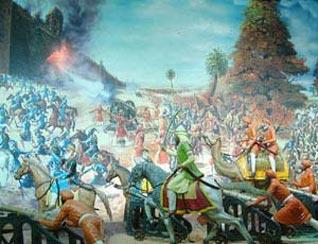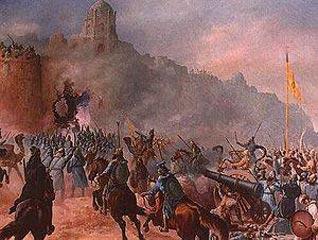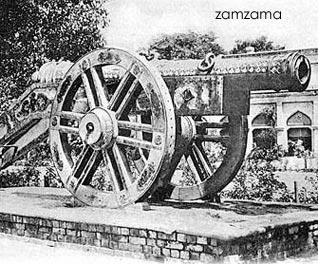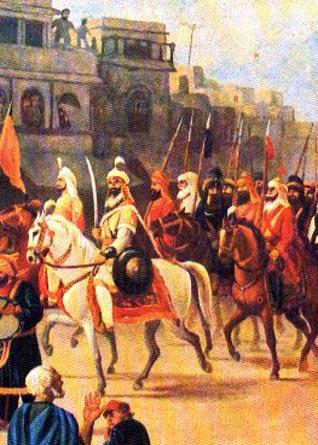History
The Battle of Multan - 1818
by MADAN SINGH
Multan is a major town on the subcontinent - now in Pakistan - on the banks of the River Indus. A major trading centre, its strategic importance cannot be under rated.
Maharajah Ranjit Singh, the nineteenrth century Emperor of Punjab who ruled from Lahore, decided to incorporate it in the Sikh Empire. Accordingly a force of 25,000 Sikh soldiers were advanced on Multan.
Significance of Ranjit Singh's Western Campaigns
Ranjit Singh had signed a treaty with the English, whereby he agreed not to cross the River Sutlej (the northern border of British India) in return for a rich tribute to be paid by the British to the Sikhs annually.
He advanced against the western areas bordering his state to secure his kingdom from the ongoing menace of Afghan invasions. Thus, he mounted several campaigns against the Afghans. The significance of these campaigns rests on the fact that this was the only occasion in history when the Afghans were contained and defeated. Hitherto, in all other cases the invaders came into Punjab from the west and central Asia, but Ranjit Singh broke this tide by moving in the reverse direction.
He won notable victories and captured Peshawar and Multan, including Kashmir and Ladakh (under General Zorawar Singh)
The Sikh Army was led by Hari Singh Nalwa, a legendary general of Ranjit Singh and his second in command was Mohkam Chand. The elder son of Ranjit Singh, Kharak Singh also took part in this battle, but he was a nominal commander. The battle lasted from March till the Afghan surrender on June 2, 1818.
The Sikhs were opposed by a formidable force under Muzzafar Khan Sadozi. He had about 13000 troops holed up inside Multan Fort with him. The fort itself was to a degree impregnable and the Sikh Amy laid siege to the city.
The BattleDespite heavy bombardment and raids by the Sikhs, the fortress held on and messages were passed to Ranjit Singh to dispatch heavy artillery. One advantage with the Sikhs was that the River Indus served as an excellent conduit for transporting troops and guns from Lahore. Thus the supply chain to Multan could be maintained and heavy guns were transported via the river. In fact the Sikhs had started preparing for the campaign from January 1818 itself.
Ranjit Singh responded to the request of his generals and heavy guns - including his famous ZamZama cannon - were transported by river craft to reinforce the Sikh soldiers besieging Multan. These opened up and a barrage on the fortress commenced. The result was disastrous for the defenders as a portion of the fort wall collapsed and a breach was created. The Sikh General, Hari Singh, now mounted an assault on the fort and the army could enter Multan through the breach.
The Result of the Battle
The battle was now ferocious as the Sikhs attacked the defenders. The Sikhs suffered nearly 1900 causalities. Muzzafar Khan and his sons were killed and the remaining force surrendered and allowed the city to be incorporated as part of the Sikh empire.
The city remained a part of the Sikh empire, though it had a majority Muslim population. However, after the death of Ranjit Singh, the Sikh empire broke up and the British captured Multan.
But this reduction of the Multan fortress will remain a magnificent tribute to the fighting qualities of the Sikh Army and the generalship of Hari Singh Nalwa.
[Courtesy: Suite 101. Revised for sikhchic.com]
January 21, 2011
Conversation about this article
1: Kuldip Singh (Brampton, Ontario, Canada), January 21, 2011, 9:53 AM.
Sher-e-Punjab Ranjit Singh!
2: Surinder (Massachusetts, U.S.A.), January 21, 2011, 11:02 AM.
Victory belongs to the Almighty, the Deathless. Such inspiring stories make me intensely proud. We need more of such inspiring stories to keep our morale up, to remember our strengths and to never forget them.
3: Harcharn Kaur (Toronto, Ontario, Canada), January 21, 2011, 1:14 PM.
Not our strengths. But the strength of our ancestors. In our current state, we can't defend ourselves or our homes, let alone charge into a battle. To many of us have become weak-hearted.
4: Surinder (Massachusetts, U.S.A.), January 21, 2011, 5:56 PM.
Bhenji Harcharan Kaur ji, I stand corrected: Strength of our ancestors, not ours. While in 1818, we conquered Multan, recently in 1947 we lost it!
5: Jaspal Singh (Mohali, Punjab), April 17, 2017, 5:43 AM.
Manyog S. Madan Singh ji: thank you for sharing this great piece of Sikh history. But here I would like to mention that the real story of the valour of the Khalsa is still missing from it. One of the crucial cannons being used during the battle broke its wheel; without it, the cannon could no longer function. Hence, one by one, Khalsa warriors offered themselves to support the weight of the gun on their shoulders, which would allow the cannon to fire but which also meant sure death for the volunteer because of the tremendous kick from the recoil from each firing. A whole line of sant-sipahis stood in line, waiting for their turn. The jathedar (unit commander) joined the lineup alongside his braves. Altogether, 17 soldiers thus attained martyrdom and the enemy's wall was breached successfully. Regret that today our so called jathedars are concerned only with the golak and have lost their Sikhi and the strength of character that comes with it.






